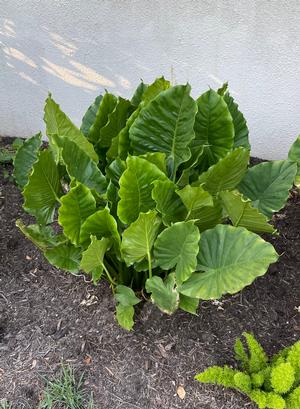
Mortellaro's Nursery
Print This Page




Alocasia Elephant Ear from Mortellaros
Elephant Ear
Alocasia sp.
Alocasia, often referred to as Elephant Ear, is a striking tropical plant grown for its large, upright, arrowhead-shaped leaves and bold architectural presence. Though the name “elephant ear” is often applied to several genera, Alocasia differs distinctly from Colocasia: its leaves stand upright or outward and are usually thicker, glossier, and more deeply veined. The point of attachment to the leaf is not central, creating a more angular, shield-like appearance. In contrast, Colocasia typically has drooping, heart-shaped leaves that attach centrally and face downward.
In the landscape, Alocasia is best used in shaded to part-shade areas or containers placed out of the afternoon sun. It performs well in rich, well-drained soil that stays evenly moist, but not soggy. Alocasia is less tolerant of wet soils and full sun than Colocasia, making it better suited for protected patios, north-facing beds, or under high tree canopies in Central and East Texas. Leaves can reach 2–3 feet long, with plants maturing between 3–6 feet tall, depending on variety. Space plants 3–4 feet apart if grown in ground beds.
While cold-sensitive, Alocasia can be grown as a warm-season annual or overwintered indoors in containers. In USDA Zone 9 and warmer, some varieties may return from tubers with protection. In Central Texas, treat it as a tropical that needs to be dug up or brought indoors before frost. Fertilize monthly during the growing season for best leaf size and color.
 |
Water Garden Plant |
 |
Accent Plant |
 |
Containers |
 |
Tropical |
Height:3-6 Feet |
Spread:3-6 Feet |
Spacing:3-4 feet |
Interesting Notes
Entire plant is poisonous if ingested.
Sap is skin irritant.
USDA Hardiness Zone 8a
Characteristics & Attributes
|
Deer Tolerance
|
Exposure
|
Habit
|
Soil pH Preference
|
||||||||||||
|
Water Needs
|
Tolerates Poor Drainage
|
